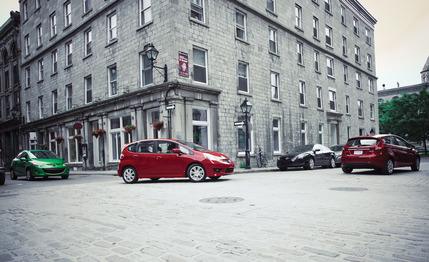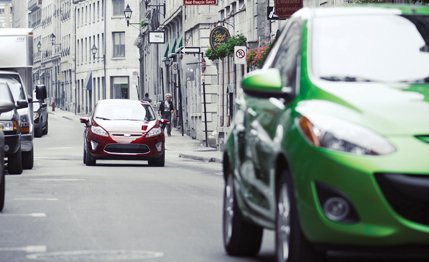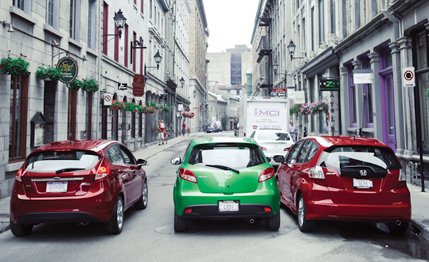 Comparison Tests
Comparison Tests

Most drivers in Europe motor around in small, efficient hatchbacks without feeling like failures. But here, in America—the hell with the gas bill—size still matters. On the Continent, the social stigma that’s attached to driving a very small car isn’t as virulent and deprecating as it continues to be for many drivers in the U.S.
So Ford is trying, once again, to take the edge off that particular shame with its latest Fiesta—a snazzy-looking, Euro-transplant B-segment subcompact that emphasizes lots of features and high fuel economy. Mazda enters the fray with its 2, first released in Europe in 2007 and, ironically, riding on the same platform as the Fiesta (they share the same 98.0-inch wheelbase). These new releases make Honda’s product planners look like fortune tellers who were right to take a chance on bringing the first-generation Fit here in 2006, then following up in 2009 with the second-generation model.
Because these cars extol the European automotive virtues of snappy handling and fuel efficiency, we decided to test them in the most European-feeling city in North America: Montreal. The city is actually on an island in the vast St. Lawrence River, and the old quarter has cobblestone streets filled with ancient churches, beckoning cafés, and charcuteries. As in Europe, most of the population speaks a language you don’t, although some Montréalais defaulted into English after encountering a few seconds of our blank staring.
The 600-mile trip from Ann Arbor to Montreal is almost as far as a run from Paris to Berlin. Our hot day began with distinct Euro flair at lunch in southern Ontario, where our finicky managing editor was alarmed to see his root beer served without ice. Zut alors! Speaking of refreshment, all three cars come standard with air conditioning, even at their dollar-menu starting prices. The Fiesta begins at $13,995 in four-door trim. If you prefer, as we do, the style of the five-door, the minimum is $15,795. The Mazda and Honda come in one body style only and start at $14,730 and $15,650, respectively. In instant-ramen trim, all three of these cars have anti-lock brakes, power windows and locks, and plenty of airbags.

For our test, though, we rounded up the more “luxurious” versions. The feature-heavy Fiesta SES comes with 16-inch alloy wheels, cruise control, LED parking lights decked out with chrome, satellite radio, and the Sync infotainment system. Another $795 adds a package with keyless ignition, heated front seats, and extra chrome. As-tested price: $18,770.

Honda also throws 16-inch alloys on the uplevel Fit Sport, in addition to a body kit, chrome exhaust tips, fog lights, cruise control, remote entry, and a rear anti-roll bar. Navigation and stability control (our test car was produced early in the year, before the ability to combine this option with the manual transmission disappeared) cost an extra $1850. Add in dealer-installed rubber floor mats, for $130, and our test car rang up at a rich $19,140.
“Sport” indicates the base Mazda 2 trim. We sampled the grander Touring model, with alloy wheels, fog lights, cruise control, a leather-wrapped steering wheel with audio controls, a trip computer, and a rear spoiler. All that added up to $16,185, nearly three grand cheaper than the Fit.

After more than 1300 miles of mostly suffering through Ontario’s 401 freeway (think Nebraska), touring Montreal’s environs, and exploring the edge of the wilderness of Quebec, we can report with assurance that none of these diminutive hatches suffers from a Napoleon complex. All three belong at the top of the heap in the subcompact class, and one belongs at the very top.